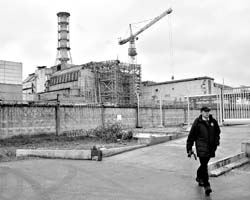Nuclear consensus to result in roof for Chernobyl Nuclear Power Plant and nuclear waste depository

A new stage in resolving the issue of nuclear security has begun in Ukraine. Its official beginning was marked by the signing of two important contracts by Ihor Hramotkin, general director of the Chornobyl Nuclear Power Plant at the Presidential Secretariat. The first contract, signed with the French consortium Novarka, entails the building of a new safe containment (NBK) to isolate the damaged fourth reactor, and the second one — with the US Holtec International Consortium, which will build a second storage facility for spent nuclear fuel from the Chornobyl plant.
The significance of this event was underlined by the presence of President Viktor Yushchenko and Jean Lemierre, the president of the European Bank for Reconstruction and Development (EBRD). After 12 long years of engineering, political, technological, and financial research Ukraine is finally approaching the concrete resolution of this painful issue.
“The signing of the agreement to build safe containment and storage facility for spent nuclear fuel is the start of a global project in the area of nuclear security, where Ukraine is cooperating with the world’s leading countries, above all with donor-countries. This is the first step, a practical one, which means that we are launching concrete actions to transform the fourth reactor and the entire nuclear plant into an ecologically safe place,” said deputy head of the Presidential Secretariat Dmytro Chaly before signing the documents.
Both projects cost a lot, he says. One project requires 505 million dollars and five years to build the containment, and 200 million dollars and 52 months to build the storage facility. The work will be financed by the Chornobyl Ukryttia Foundation and the Nuclear Safety Account (NSA) managed by the EBRD. The international donors confirmed their intention to allot money to Ukraine on July 17-18, 2007, at a gathering in London. The Ukrainian president says that the current funds in the foundation’s account will allow Ukraine to finance two-thirds of the work. Negotiations with the international community will be held concerning the further replenishment of the foundation’s account.
Speaking about the potential changes to the sums allotted for the projects as the work proceeds, Hramotkin explained, “We are real people, we walk upon the earth and see that prices for construction materials have escalated by nearly 50 percent. The cost of labor is increasing by the hour, not by the day. There are certain indices and factors that allow us to calculate the inflation rate. Therefore, we have been trying for nearly a year to coordinate these factors in order to protect ourselves, the client, on the one hand, and on the other, to enable the contractor to fulfill his duties according to the agreement.” These factors take two indices into account: the cost of construction materials and labor.
The contractor is fully responsible for completing the difficult task ahead. However, the Ukrainian client will participate as well. According to the signed contracts, Ukraine can recommend potential subcontractors to the contractor. The general director of the Chornobyl Nuclear Power Plant did not name his future Ukrainian assistants, but admits that both enterprises and scientific-research institutes may apply their efforts. “We will only recommend, and, accordingly, ask about the achieved result,” Hramotkin said.
Speaking about the construction of the new containment, the general director of the Chornobyl Nuclear Power Plant announced that the work will be completed in several stages. “The initial phase, which includes designing and licensing when the project undergoes state expertise,” has already begun. All this will take 1.5 years, according to approximate estimates. “We have taken into account our previous experience, and even the designing stage will include intermediate phases, when the contractor will report on the state of the design work,” Hramotkin explained. He added that the physical fulfillment of the plan can be discussed only with the state’s approval. The new nuclear power wonder will resemble an arch 105 meters high, 150 meters long, and 260 meters wide on the outside. It will be constructed at the Chornobyl Nuclear Power Plant, and afterwards rails will shunt it onto reactor no. 4. The steel construction will weigh 20,000 tons. The minimum period of operations is a hundred years. After completing the work on the safe containment installation, “the unstable elements will start to be dismantled.”
At a meeting with journalists the fate of another nuclear power installation was announced. Only nuclear waste produced by the Chornobyl Nuclear Power Plant will be stored in the new storage facility. It is not inconceivable that in the future it will be possible to use waste as an energy source for new-generation reactors. Projects to design nuclear containers, proposed by the builders, may be of assistance here.






